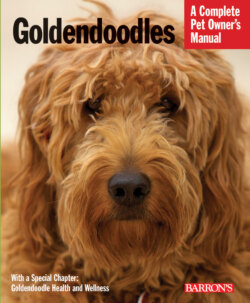Читать книгу Goldendoodles - Edie Mackenzie - Страница 11
На сайте Литреса книга снята с продажи.
Generations
ОглавлениеUntil recent advances in canine genetic testing allowed for significantly higher levels of accuracy in terms of coat length, curl, furnishings, and nonshedding in the first breeding of a Golden Retriever and a Poodle, many breeders relied on the antiquated concept of hybrid vigor and their own experience with their breeding dogs. Hybrid vigor derives from the idea that the offspring of two unrelated breeds of the same species will receive all of the parents’ good traits and few of the bad. This works as long as the parent breeds do not have a common gene for a genetic defect.
Genetic testing for coat type has eliminated the need for additional backcrossing and multiple generations in breeding. However, there are many good breeders, prior to the availability of genetic testing for coat type, who invested a tremendous amount of time and energy to develop health-tested breeding lines that produce consistently reliable nonshedding coats—and the quality of the dogs they breed should not be discounted. So, let’s take a look at the various generations of Goldendoodles. You can work with either a breeder who does genetic testing for coat quality and/or a long-time breeder whose experience and commitment has also resulted in top-quality Goldendoodles.
It is critical that both breeding parents and, ideally, the previous generations are tested for, and pass, all the potential genetic defects and diseases (see “Health and Wellness,” pages 44–46).
F1 The breeding of a Golden Retriever with one of the following four sizes of Poodle—Standard, Moyen/Klein (medium), Miniature, and Toy—results in a litter of F1 puppies or First Generation. “F” stands for the Latin word filial or generation. Both Golden Retrievers and Poodles have the recessive gene for long coats; therefore, F1 Goldendoodles carry two genes for long coats. Because of the two long coat genes, many Goldendoodle breeders don’t breed beyond the initial pairing of the Golden Retriever and the Poodle.
F1b The F1b Goldendoodle is the breeding of an F1 Goldendoodle backcrossed (b) with a Poodle. This yields a dog twenty-five percent Golden Retriever and seventy-five percent Poodle. By adding more Poodle into the genetic mix, the likelihood of a curly, nonallergy-inducing coat is higher. As noted above, genetic testing for coat length, curl, furnishings, and nonshedding attributes now make this backcrossing unnecessary. However, not all breeders are up to speed with genetic testing for coat-related genes and may successfully produce reliable coats without genetic testing.
F2 The F2 Goldendoodle results when both parents are F1 Goldendoodles. While this yields a dog that is still fifty percent Golden Retriever and fifty percent Poodle, the F2 is a more genetically diverse dog than the F1. The primary advantage of F2 breeding is the ability to select the most desirable traits from a breeder’s F1 Goldendoodles and reproduce them consistently.
Multigen According to GANA, the multigen (multiple generational) Goldendoodle is the result of breeding two Goldendoodles. However, unlike the F2, one of the multigen parents must be either an F1b Goldendoodle or another multigen Goldendoodle.
Additionally, a multigen Goldendoodle bred to a Poodle is also considered a multigen Goldendoodle.
Reprinted with permission from Goldendoodle Association of North America (GANA), 2018.
